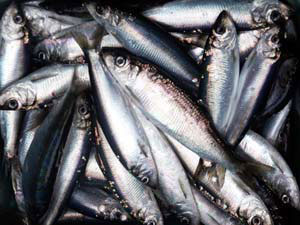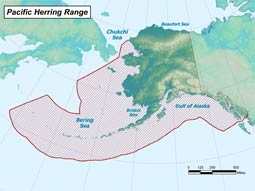Pacific Herring
(Clupea pallasii)
Species Profile
Did You Know?
The time it takes for Pacific herring eggs to hatch is dependent on the water temperature.
General Description
Herring have a blue-green upper body with silvery sides and are devoid of markings. The body is laterally compressed and the scales along the underside project in a slightly serrated arrangement. Scales are large and easily removed. Their tails are deeply forked and they lack adipose fins. These fish may grow to 18 inches in length, but a 9-inch specimen is considered large.
Their blue-green upper body, large scales, and large eyes help distinguish them from other silver fish species of similar size.
Life History
Growth and Reproduction
Pacific herring are sexually mature at 3–4 years of age and spawn every year after reaching maturity. Spawning occurs in the spring in shallow, vegetated areas in intertidal and subtidal zones. Males and females release their milt and eggs into the water column where they mix and fertilize. The eggs are adhesive and attach to vegetation or the bottom substrate.
Eggs hatch about two weeks after fertilization and the young larvae drift and swim in the ocean currents. Once the larvae undergo metamorphosis into their juvenile stage, they rear in sheltered bays and inlets. In the fall, the schools of juveniles move to deeper water where they will spend the next 2-3 years. They will remain separate from the adult population until they are mature.
Feeding Ecology
Pacific herring feed seasonally on phytoplankton and zooplankton, building up fat stores for periods of inactivity. They generally feed in surface waters at night in areas of upwelling. Young herring feed mainly on crustaceans but will eat decapods and mollusk larvae. Adults consume mostly large crustaceans and small fish.
Behavior
Pacific herring travel in large schools.
Migration
Pacific herring travel to inshore waters to spawn then migrate back to offshore waters to feed. They exhibit a diel vertical migration pattern, remaining near the bottom during the daylight hours and moving to shallow waters to feed at night.
Range and Habitat
Pacific herring are found throughout coastal waters of the Pacific Ocean. In the western North Pacific, they are found in the western Bering Sea to Kamchatka, in the Okhotsk Sea, and around Hokkaido, Japan southeast to the Yellow Sea. In the eastern North Pacific, they range from Baja California north to the Beaufort Sea. They also occur in the Russian Arctic from the Chukchi Sea to the White Sea.
Pacific herring spawn in inshore waters and feed in offshore waters. They occupy the water column from the surface to depths of 1300 feet.
Status, Trends, and Threats
Status
Herring population abundance trends are very dynamic and are subject to fairly substantial changes on both large and small geographic scales. The primary cause for such fluctuations in abundance is environmental change that affects herring growth and recruitment.
NatureServe: National – N5 (Apparently secure)
ESA: Not warranted
Trends
Overall, Alaska herring stocks are well managed for their long-term sustained yield. In Southeast Alaska, herring abundance is trending upwards since 1980. The Pacific herring population in Prince William Sound collapsed in 1993, 4 years after the Exxon Valdez oil spill. The cause has yet to be determined and the population has shown little sign of recovery.
Threats
A threat to Pacific herring is the loss of spawning grounds. This habitat has been degraded or destroyed by dredging, construction activities, log storage, oil spills, and decreases in water quality. Global warming may also pose a threat to the species by reducing the availability of their prey; zooplankton and phytoplankton. In addition, the recovery of populations of predator species, such as humpback whales, may impact herring populations.
Fast Facts
-
Size
Can grow up to 18 inches -
Lifespan
8–16 years -
Range/Distribution
Coastal waters throughout the Pacific Ocean -
Diet
Zooplankton and phytoplankton -
Predators
Other fish, marine mammals, and birds -
Reproduction
Mass spawners with external fertilization


